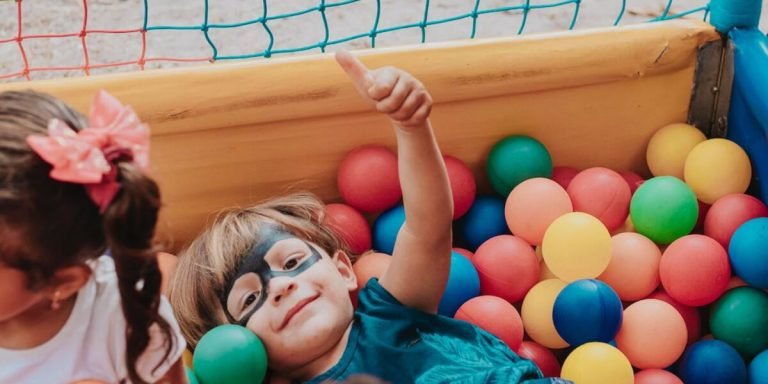Kinesthetic Learning Examples: Exploration in Childhood Education
The early years of a child’s life are foundational for cognitive development and set the groundwork for future learning abilities. While there are many ways to facilitate this, one effective method brought into sharp focus by educators worldwide is kinesthetic learning examples. Kinesthetic or ‘hands-on’ approach taps into children’s inherent desire to explore their surroundings.
This strategy, also known as Activity-Based Learning (ABL), encourages youngsters to learn through physical activities rather than traditional lecture-based instruction methods. Through ABL, not only do they build comprehension but foster creativity and imagination too – vital pillars of innovative thinking in adulthood.
Did you know?
Did you know? Research reveals that kinesthetic learning is not just for physical skills, but it can also improve language acquisition. A study published in the “Child Development” journal found children remember new words better when they physically act them out – an aspect of kinesthetic learning!
Understanding Activity-Based Learning: Bridging Theory and Practice
In today’s digital age, integrating technology into education is no longer a luxury but rather an imperative. More and more educators continue to incorporate tech tools within the classroom setting and one fundamental technique often adopted is ‘Activity-Based Learning’ (ABL). This approach assists in bridging theory with practice, by transporting students from passive listeners to active participants where they can learn at their own pace.
Delving deeper into activity-based learning exposes us to ‘kinesthetic learning’, which draws upon physical activities instead of simply listening or observing. Kinesthetic learners are those who acquire knowledge most efficiently when physically engaged during instruction. Therefore, comprehending kinesthetic learning examples becomes essential for creating effective educational environments that utilize this instructional strategy optimally.
A prime example would be using interactive software during math lessons – such as virtual geometric sketchpads – allowing children hands-on exploration of shapes and angles through manipulation on screen touching interface extensively boosting spatial reasoning skills. Similarly coding programs encouraging kids to design animations or games also stands as stellar practical instance by providing young minds tangible experience while fostering logic building skill set.
Defining Kinesthetic Learning in Modern Education
Kinesthetic learning, a term coined from the science of kinesiology, refers to a style of teaching and studying that integrates physical activities into daily lessons. In today’s education system, it is gaining steam due to its emphasis on engaging children in hands-on experiences as an effective way for them to grasp new concepts.
In essence, kinesthetic learning speaks directly about “learning by doing”. Rather than adhering strictly to memorizing facts or listening passively during lectures, students are encouraged instead to touch items related & participate actively in real-life scenarios that signify what they’re being taught. From basic math games with manipulatives for younger children up till complex chemistry experiments for older ones – active participation ensures concept clarity builds over time.
Kinesthetic learners specifically benefit from this approach since their natural inclination towards movement dovetails perfectly with such methodology.
For instance – let’s take examples relevant here:
1. A primary school teacher focusing on geography can integrate technology like virtual reality devices allowing kids travel across different terrains around world without leaving classroom premises.
2. Similarly physics could be made more interesting by utilizing apps showing 3D simulations explaining motion laws clearly rather verbal abstract explanation only.
Technology integration plays a crucial role not just enhancing teaching methods but also making these practical exercises accessible even at home times when attending schools physically may not always possible owing evolving work-from-home culture parents adopting widely now.
The Role of Activities in Enhancing Cognitive Skills
The magic of kinesthetic learning examples, or activity-based learning, lies in its power to immerse learners into the educational experience. As we look more deeply at this method’s role in enhancing cognitive skills, it becomes crystal clear why it is a crucial part of successful teaching strategies.
Kinesthetic learning leverages our instinctive tendency for action as human beings. It creates an engaging atmosphere where children actively participate rather than merely observing lessons from the outskirts. In 2023, with technological advancements impacting every domain significantly – including education – integrating technology has become a cornerstone for improving knowledge absorption and retention among young minds.
Activity-based learning brings real-world context into classrooms by encouraging hands-on activities that facilitate practical application of theoretical concepts learned from textbooks. For instance; think about teaching mathematics – traditionally considered tedious due to complex numerical problems and abstract theories- through games involving counting blocks or puzzles demonstrating geometrical shapes! This approach transforms otherwise monotonous subjects into interactive experiences brimming with thrill and discovery!
Moreover, many studies have proven that students understand better when they ‘do’ instead of just ‘listen’. They are likely to remember what they experienced over time than something heard passively once upon a time during classes sessions—putting practice ahead theory-oriented pedagogy leads long-term memory consolidation process.
Another significant perspective pertains not only towards academic performance but also holistic child development overall: fostering creativity critical thinking abilities . Learning using active exploratory methods encourages curiosity innovation while simultaneously sharpening problem-solving capability .
Real-World Applications of Kinesthetic Learning Examples
In our rapidly advancing digital age, the integration of technology in education is a development that cannot be overlooked. One particularly valuable approach for today’s digitally-savvy children involves kinesthetic learning examples which blend seamlessly with modern edtech solutions. Incorporating real-world applications into these activity-based experiences allows young learners to connect abstract knowledge with tangible experience.
Kinesthetic learning strategy comprises actions such as movement and touch to stimulate understanding and retention of information by students. In this regard, educational technologies come in handy in providing virtual yet almost realistic environments where students can indulge their senses while mastering academic content.
Imagine teaching geography using interactive maps on tablets or history through chronological reconstructions via augmented reality (AR) glasses; this isn’t just theoretical concept anymore but an application existing classrooms are adopting. Hence, not only does applying kinesthetic learning methods help cater to different learner types but also motivates active participation from all pupils – making the whole process more engaging and beneficial.
Moreover, designing lessons that link physical activities directly tied to curriculum objectives introduces innovative ways students understand complex concepts better without feeling pressured under traditional instruction techniques- thus encouraging lifelong love for learning among them.
Integrating Movement with Academic Concepts
The integration of movement with academic concepts brings forth a unique approach to education known as Kinesthetic Learning. Often overlooked, this method has started gaining recognition due to its effectiveness in enhancing the learning experience for children. With dynamic teaching tools and interactive technologies proliferating classrooms worldwide, many kinesthetic learning examples stand out that showcase how technology can be seamlessly woven into an activity-based curriculum.
One prominent example is found in mathematics lessons where movement and physical interaction have been used effectively by teachers across different grade levels. In younger classes, abstraction can often hinder comprehension when numbers are introduced initially; here comes into play the use of manipulatives like counting beads or blocks. Teachers guide students’ hand movements along these objects which instills a tangible sense of number values and operations.
Turning our attention towards science teachings, simulation software provides real-time visualizations helping learners understand natural phenomena from geology to astronomy better – thereby merging screen-interaction with cognitive understanding.
Moreover, creative subjects such as language arts have not remained untouched either by kinetic activities boosting engagement significantly. A classroom scene could see students expressing poetry through embodied actions tracing consonants while speaking them aloud – creating multisensory links between sounds and symbols on paper; similarly dance choreographies might narrate storylines driving literature discussions deeper at heart level than mere text-reading ever could manage alone!
Case Studies: Successful Activity-Based Learning Programs
The value of activity-based learning programs becomes especially clear when we analyze real-world case studies. Throughout these examples, we can explore how technology plays a crucial role in structuring and implementing kinesthetic learning.
Firstly, let’s examine the class environment at Montessori schools around the world. These institutions have emphasized interactive experiences since their inception but with advancements in education tech tools over recent years, they’ve been able to optimize their methods further. For example, iPads filled with specially-designed apps offer students problem-solving tasks leading to effective hands-on understanding of concepts like number operations or letter formations.
Second on our list is The University of Chicago’s Urban Education Institute that saw notable improvements through integrating kinesthetic activities into lesson plans across various ages and subjects linguistics being one prime illustration for this strategy’s efficacy; using interactive games involving vocabulary building augmented student engagement massively thus amplifying language acquisition rates impressively.
Designing Effective Kinesthetic Activities for Diverse Classrooms
In the realm of childhood education, it has become increasingly pivotal to construct learning environments that cater to a multitude of student competencies. For instance, kinesthetic learning – an approach wherein children grasp concepts better by physically engaging in activities – is transforming classroom experiences far and wide. By designing effective kinesthetic exercises tailored for diverse classrooms, educators are not only making lessons more interactive but also enabling students’ full potential.
Technology integration plays a significant role here as we move towards Activity-Based Learning (ABL), heightening the efficacy of these practices manifold times. In 2023’s digital era where technology interfaces are omnipresent, they offer endless possibilities for incorporating active participation into school curriculums across all ages and subjects.
With imaginative use of multimedia resources like virtual reality setups or haptic feedback tools on one hand and basic materials such as clay models or construction sets on another, teachers can craft highly immersive teaching modules elucidating complex theories with ease. It allows them to engage every child individually according to their preferred style of experiencing subject matter hands-on rather than conventionally passive absorption from textbooks alone.
The magic lies in its adaptability; be it science experiments simulating planetary motions using augmented reality powered apps or solving math puzzles through dance steps measured via wearable tech devices – there isn’t any limit when creativity meets cutting-edge educational software solutions! This synergy goes beyond merely catalyzing cognitive skills among learners; encouraging teamwork spirit alongside fostering critical problem-solving abilities too which bolsters overall personality growth amidst youngsters today.
Tailoring Activities to Accommodate Multiple Intelligence Types
In the innovative world of 21st-century education, it’s more important than ever before to accommodate multiple intelligence types in our classrooms. When structuring kinesthetic activities for diverse audiences, educators can make use of technology integration and activity-based learning strategies that cater to all kinds of learners.
Kinesthetic learning examples aren’t hard to come by if you know where to look. They revolve around movement and physical interaction with the environment or material at hand as a part of the teaching-learning process. With advancements in digital tools like virtual labs and augmented reality apps, we’re able to amplify these tactile experiences far beyond what was traditionally possible.
For instance, students may be tasked with reenacting historical events or scientific experiments using immersive VR headsets — bringing their textbook content alive right before their eyes! Alternatively, interactive whiteboard games might get them physically involved on-the-spot; enhancing both comprehension levels and participation rates simultaneously.
Educators seeking success should remember not every student shares one standard mode of cognition when they plan such tasks though – this is where Howard Gardner’s Multiple Intelligence Theory comes into play!
Strategies for Assessing Student Engagement Through Movement
Our ultimate aim as educators is to engage students in meaningful learning. In today’s technology-infused classrooms with diverse student profiles, we often need innovative strategies that leverage the power of movement or kinesthetic activity. Here are ways to assess student engagement through kinesthetic activities:
1. Collaborative Group Work: Create opportunities where learners need to move around and work together. This could include science experiments, collaborative art projects or drama enactments which all make great “kinesthetic learning examples”.
The real test will be their ability to recall concepts during regular teaching sessions.
2. Digital Scavenger Hunts: A creative way of integrating technology with physical activity includes creating digital scavenger hunts using augmented reality applications like Google Expeditions or AR Flashcards etc… Observe how quickly they solve clues pertaining directly related topics covered in classroom studies.
3.Project-Based Learning: Have your students create virtual models using software such as Minecraft Education Edition, Tinkercad 3D design tool etc.. You witness interactions among group members alongwith enhanced content understanding while working on these projects resulting excellent results on topic based assessments priorly taught via traditional method.
4.Simulation Games- Integrate educational gaming platforms like iCivics (for civics lessons), Robocode (for programming skills) into classroom teachings . Teachers get immediate feedback about each learner’s abilities from game data analytics provided by most platform providers..
Conclusion
In closing, it’s evident that kinesthetic learning examples are not just a way to keep children engaged – they’re pivotal for an immersive educational experience. Your child doesn’t simply learn by being told; they understand better through exploration and interaction.
We hope our take on ‘kinesthetic learning’ has given you a fresh perspective. We have more resources at your disposal throughout our website designed with parents and educators in mind – feel free to delve deeper into how we can best equip the next generation of imaginative minds together!







